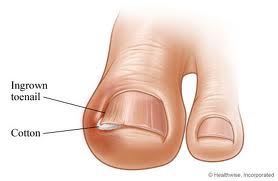Do you require permanent ingrown toenail removal surgery?
AKA partial nail avulsion
Removing the outside edge of the nail plate in a procedure known as a partial toenail avulsion is is the best permanent ingrown toenail removal surgery. The nail matrix is then permanently inhibited from ever growing that nail edge back. When performed correctly this procedure is shown to be the greatest possible option for keeping your ingrown toenail away.
Permanent ingrown toenail removal surgery
Prior to surgery- See our complete guide for Ingrown Toenails
See our complete home remedy guide on removing ingrown toenails at home. We discuss how to perform soaks to soften the skin, how to cut down the nail with very little pain and then prevent an infection from occurring in the area.
Option prior to permanent ingrown toenail removal surgery
1) Complete or partial toenail avulsion- This refers to the removal of the nail in the podiatrist’s office. The big toe is first numbed up with anesthetic so that you won’t feel a thing. The edge of the nail is then cut out, or if something is really wrong with the nail- the whole nail may be removed and allowed to then grow back. In some cases it does grow back and a nail avulsion with inhibition of the nail matrix must be attempted. In most cases this is unnecessary as the nail will grow back normally.
2) Partial toenail avulsion with nail matrix inhibition.
- If the nail regrows in the painful position, the avulsion should be attempted with chemicals or electricity to stop the nail from re-growing. Most offices will use phenol which works very well, but some people advocate that newer techniques such as using electricity or a laser to stop the nail from re-growing are the best options. Research is limited on this opinion, but the claims are decreased inflammation and more regular healing when using electricity.
3) Complete excision of the nail in the operating room.
- Although this method is the most guaranteed to work, it is usually only used if you are going into the OR for a second larger procedure like a bunion or hammertoe surgery. The cost to benefit ratio doesn’t really make sense otherwise.
Ingrown toenail removal surgery
Supplies:Sterile gloves, Iodine solution, Syringe with lidocaine, gauze, spatula, 2 straight hemostats, sterile rubber band, Nail splitter (English Anvil), electrocautery unit.
Procedure description:
1) Patient’s toe is prepped with povidone-iodine solution. Digital block is performed with lidocaine(2-3ml of lidocaine on each side of the toe).
2) The toe should be given 10 minutes to become numb.
3) The rubber band should be tied at the base of the toe to reduce bleeding during the procedure. Clamp it tight with a hemostat
4) A drape should be placed to obstruct the patient’s view to prevent fainting.
5) The outside edge of the nail should be loosened underneath with a spatula, and then the nail splitter should cut the edge all the way back to the base of the nail. The hemostat should then turn the nail in and remove it from the base. Make sure that no nail spicules remain in that area.
6) The electrocautery unit or phenol should then be applied to the nail matrix for 10-30 seconds. Make sure there is no blood in the area. If there excess granulated tissue to the area, this can then be treated as well at this point electrically or cut out.
7) Apply antibiotic ointment and put on a dressing.
8) Prescribe an anti-inflammatory medication.
To learn more about removal of ingrown toenails see this link.
No comments:
Post a Comment